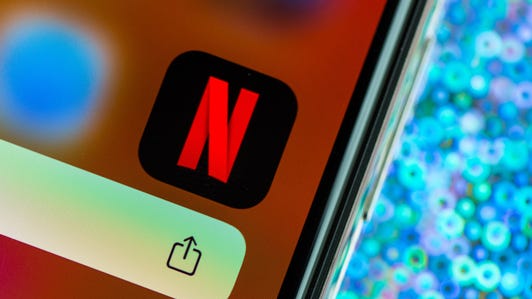Over the last two years, using the Procreate app — a CNET Editors’ Choice Award winner in 2021 — to draw on my iPad has become one of my favorite hobbies. The digital illustration app costs $10 to download, but its suite of art tools and creative features make it well worth the price.
Procreate is accessible whether you’re a design professional, a seasoned digital artist or a beginner to the world of digital illustration. Even though I’m on Procreate almost everyday, there are still features I’m discovering that improve my artwork and try new things.
Whatever your art style, you can explore the app and try out all of the different features it offers. Here are 15 tips that I’ve found most useful in my time with Procreate to work smarter, not harder:
Gesture controls
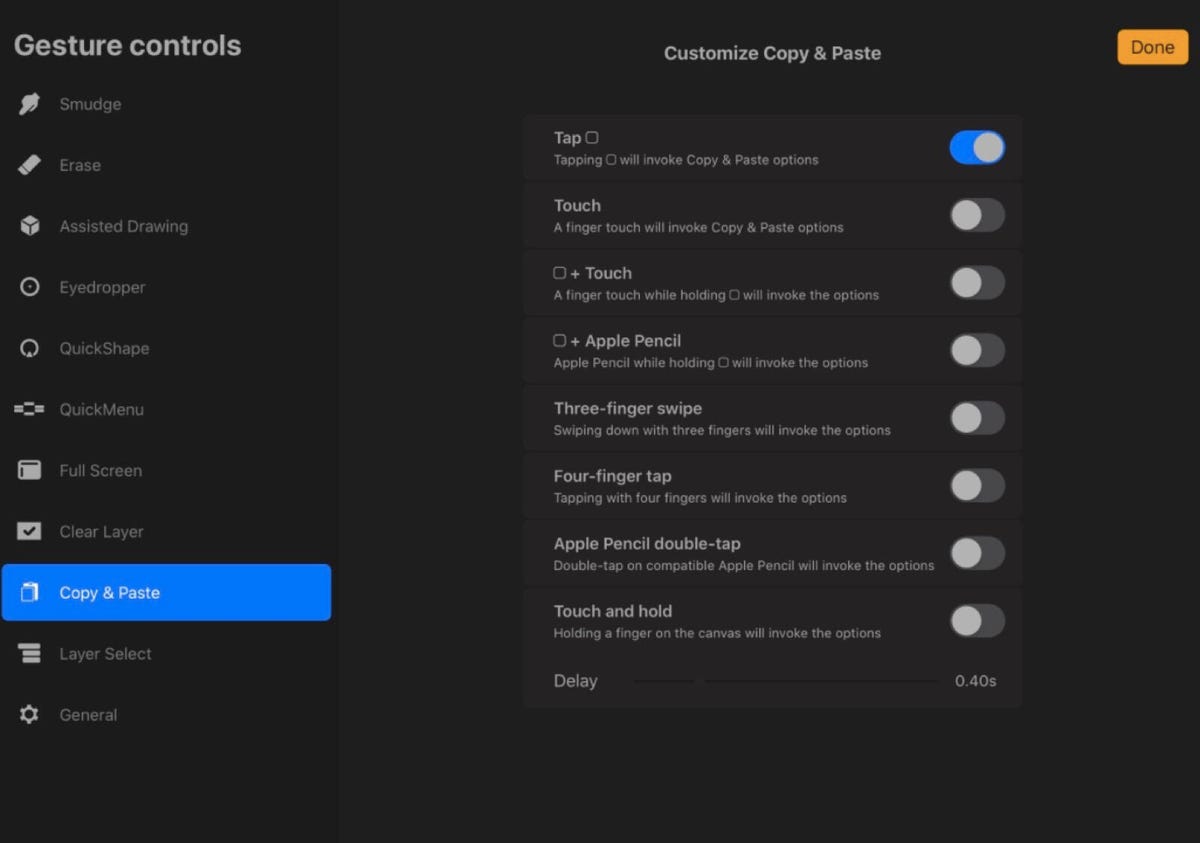

Here’s what the Gesture Control panel will look like.
Shelby Brown/CNET
iPadOS lets you use gesture controls in Procreate that can make your creative process more efficient and further personalize the app for you. You can explore all the customization options by tapping the wrench icon > Preferences > Gesture Controls. For example, you can set it so that you tap four fingers to immediately populate the copy and paste options. You can also use three fingers to scrub the screen and clear a layer. You can further customize by setting up Quick Menu in the same panel. Quick Menu provides a faster way to adjust layers, access the color panel, swap between brushes and more. To edit your Quick Menu contents, or make a new one, simple long press on any of the icons.
Read more: The best Apple iPad apps of all time
Quickshape
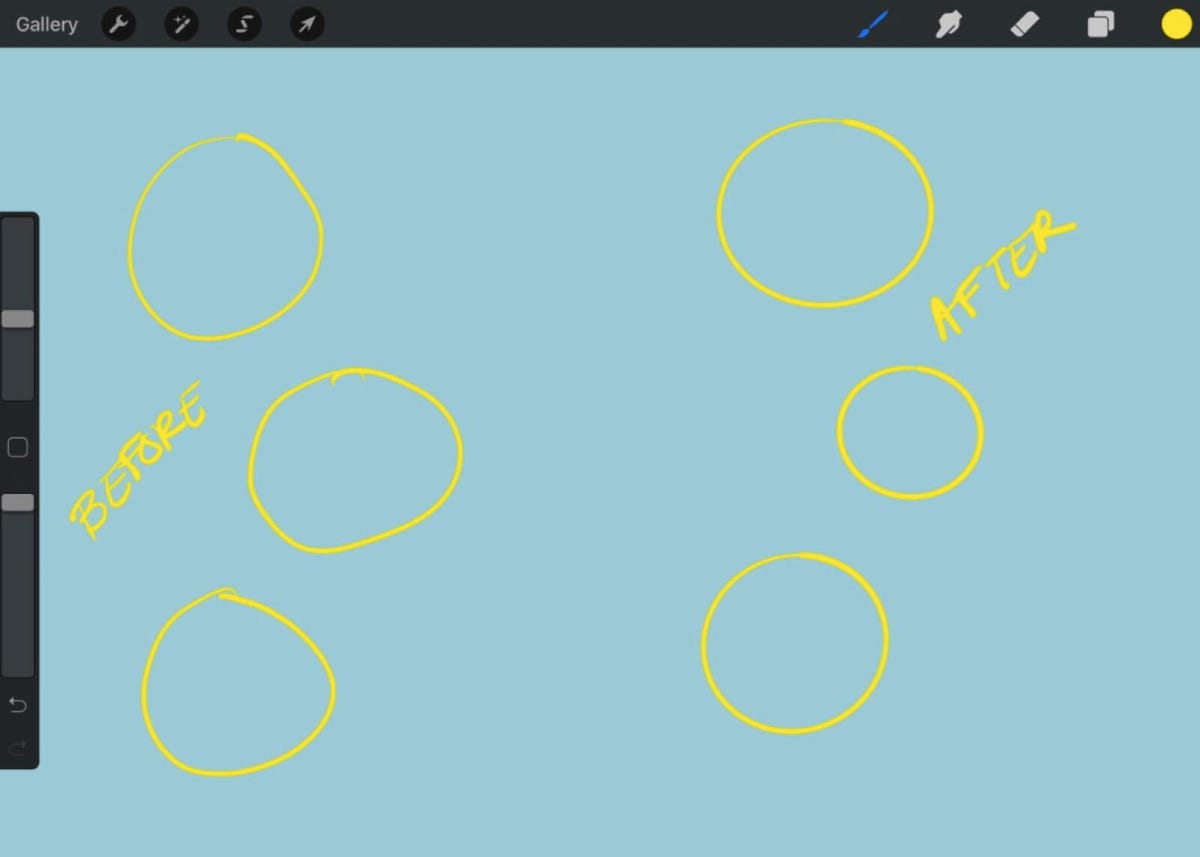

Circles, before and after Quickshape.
Shelby Brown/CNET
The Quickshape feature helps to rid your hand-drawn work of unwanted shaky lines and lopsided shapes. After Quickshape “fixes” your lines, you can hold to adjust the shape and size. You can find Quickshape by tapping the wrench icon > Preferences > Gesture Controls > Quickshape. The feature is set default as “draw and hold,” but you can customize the settings to best fit your needs.
Layers
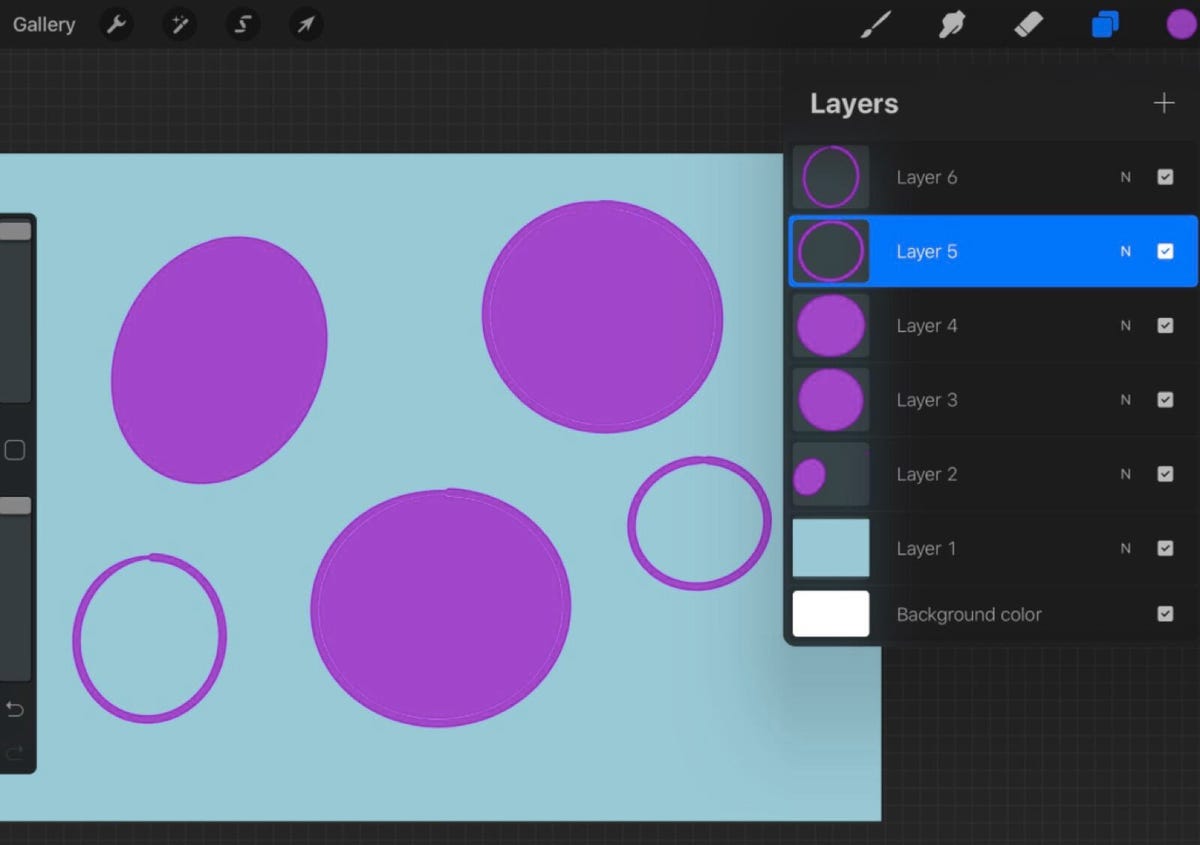

A look at Procreate’s layers panel.
Shelby Brown/CNET
Using layers is another way to add a level of professionalism to your art, and can make your work easier to edit later if needed, since you’ll have put down your drawing piece by piece. To start adding layers to your work, tap the overlapping squares in the upper right. Tap “+” to add a layer. You can also swipe on a layer to access more features like delete, lock and duplication.
You can find extra light and color editing features for each layer as well. Just tap the little “N” next to the check mark that selects the layer. There’s a lot to explore in here and my advice is to let yourself experiment. If you’re feeling totally lost, YouTuber Brave The Woods has a great video showing how it all works.
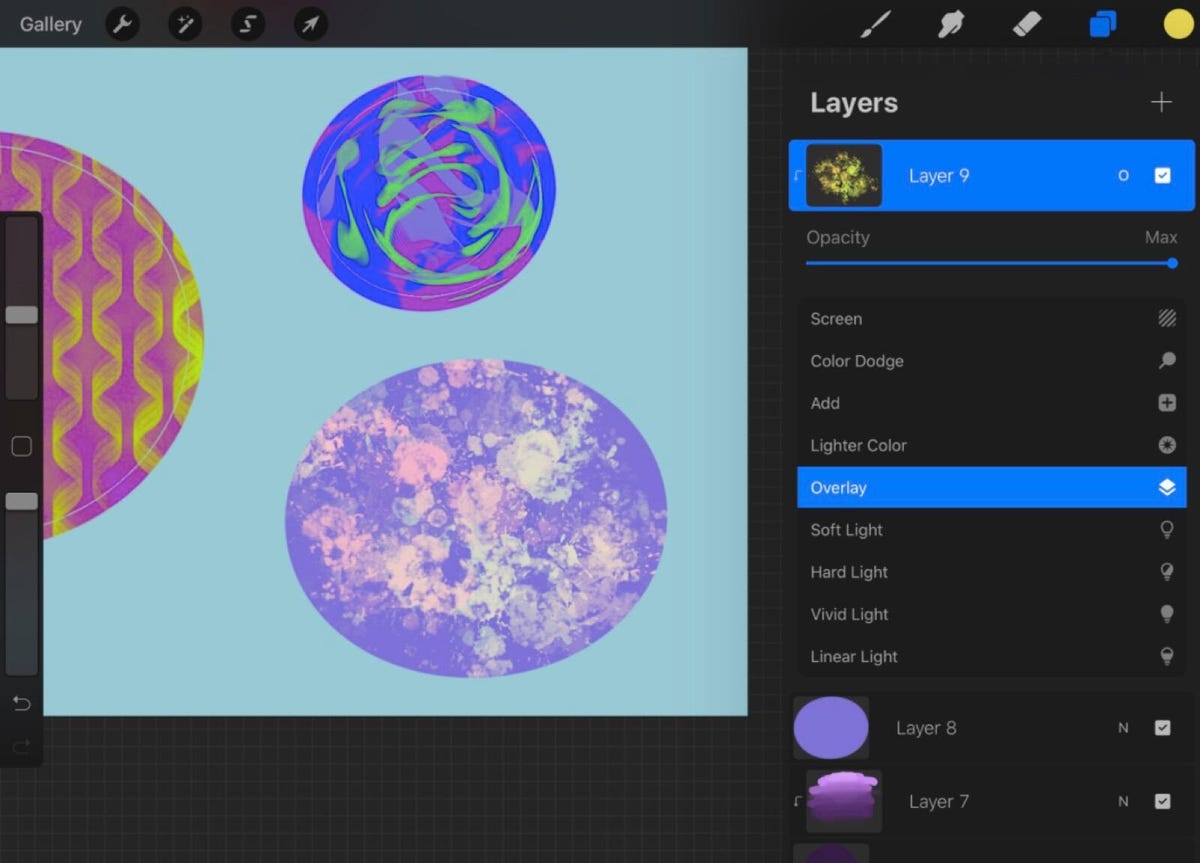

Editing options within a layer.
Shelby Brown/CNET
To stay organized, or if you want an added level of security to a section of art, you can combine layers into groups. Simply tap a layer and you can select either Merge Down or Combine Down. Merge Down makes two layers into one (i.e., if you had Alpha Lock on to protect line boundaries in a layer, it will turn off). Combine Down forms a new group, but still keeps each individual layer’s specifications active.
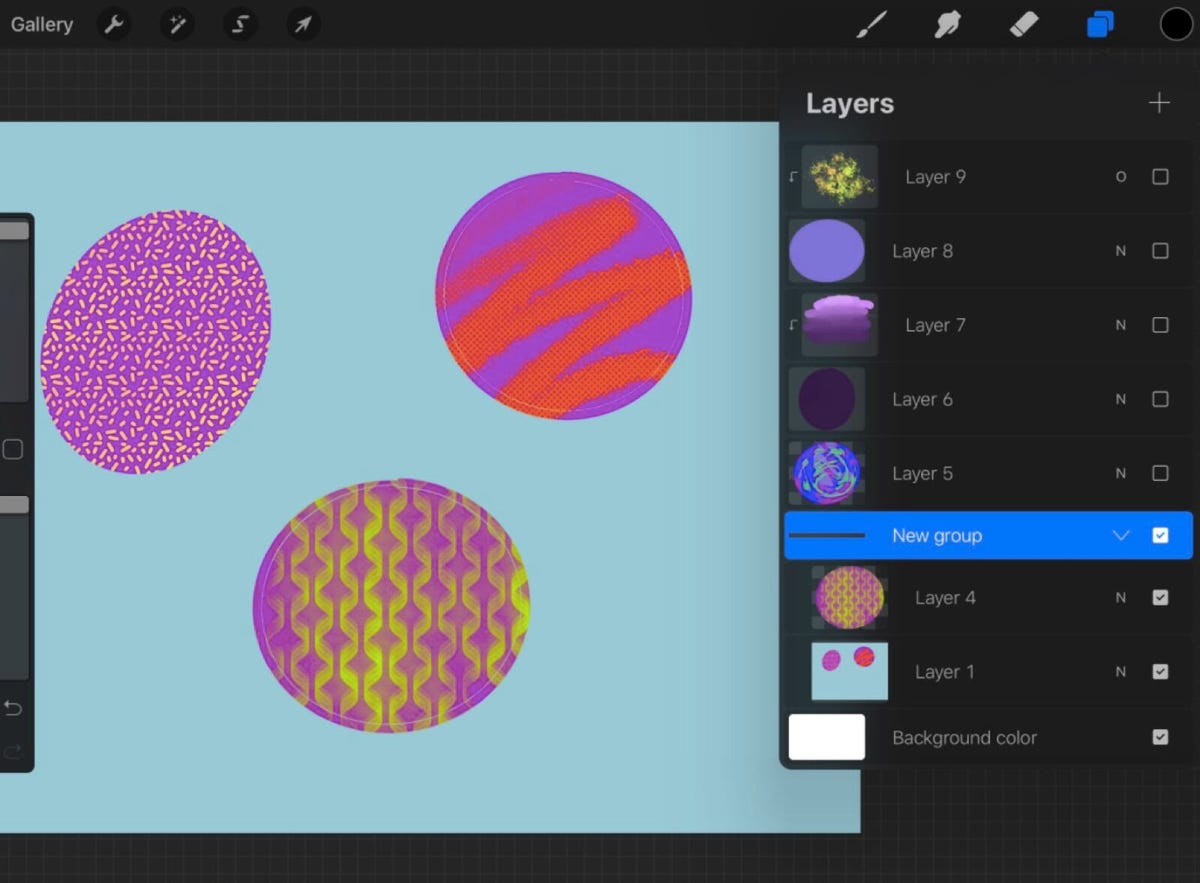

Layer 1, 2 and 3 merged, layer 4 combined and 1-4 is a group.
Shelby Brown/CNET
Read more: 5 online drawing classes you can take right now
Alpha locks
The Alpha Lock feature lets you edit a layer, but only the pixels already there, to keep what you’re drawing within a certain boundary. You can tell when Alpha Lock is turned on by the checkerboard that appears next to the thumbnail. I used Alpha Lock on layers 2, 3 and 4, for example.
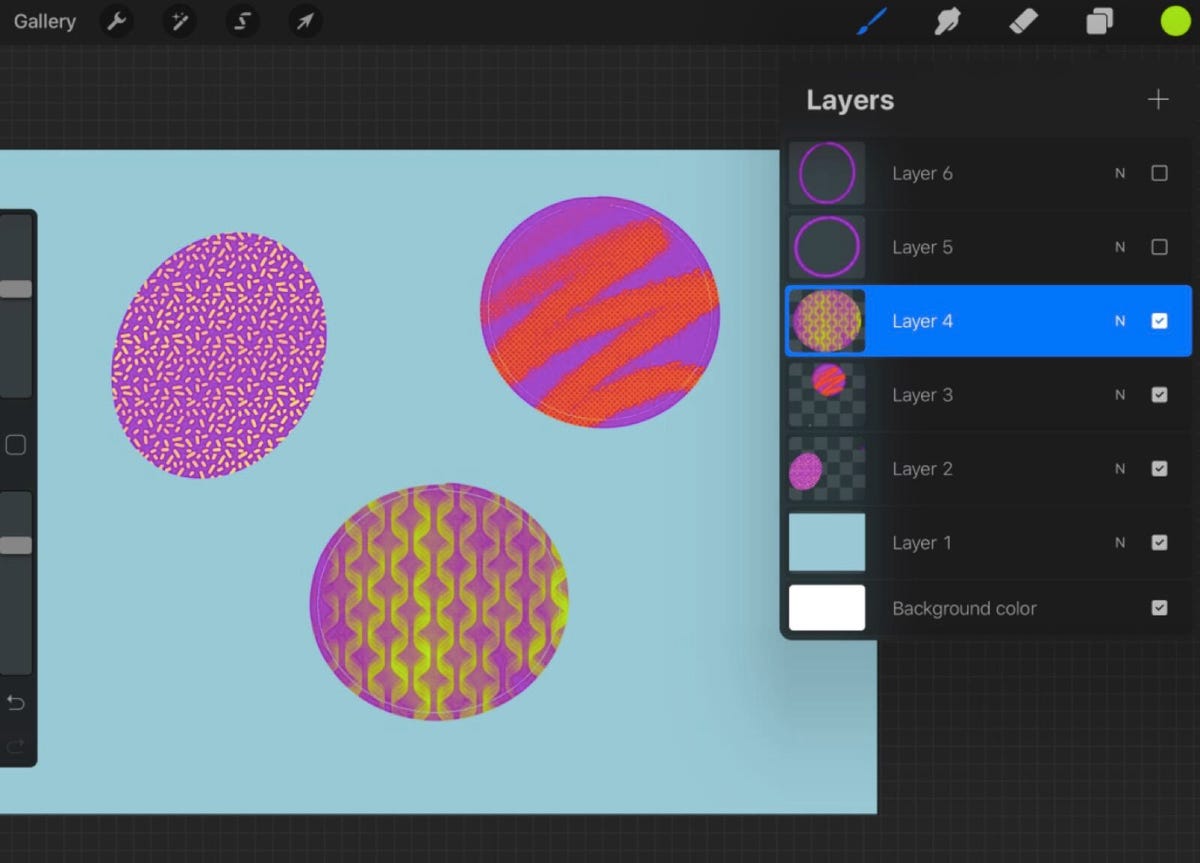

Alpha Lock enabled on layers 2, 3 and 4.
Shelby Brown/CNET
Clipping masks
Meanwhile, the Clipping Masks feature works like painter’s tape. I find it helpful when using blend mode. Create your shape on a layer and then add a new layer. Tap the newest layer and select Clipping Mask — you’ll know it worked because you’ll see a little arrow pointing to the layer below. For example, layer 7 was a clipping mask to make the blend for the circle in layer 6.
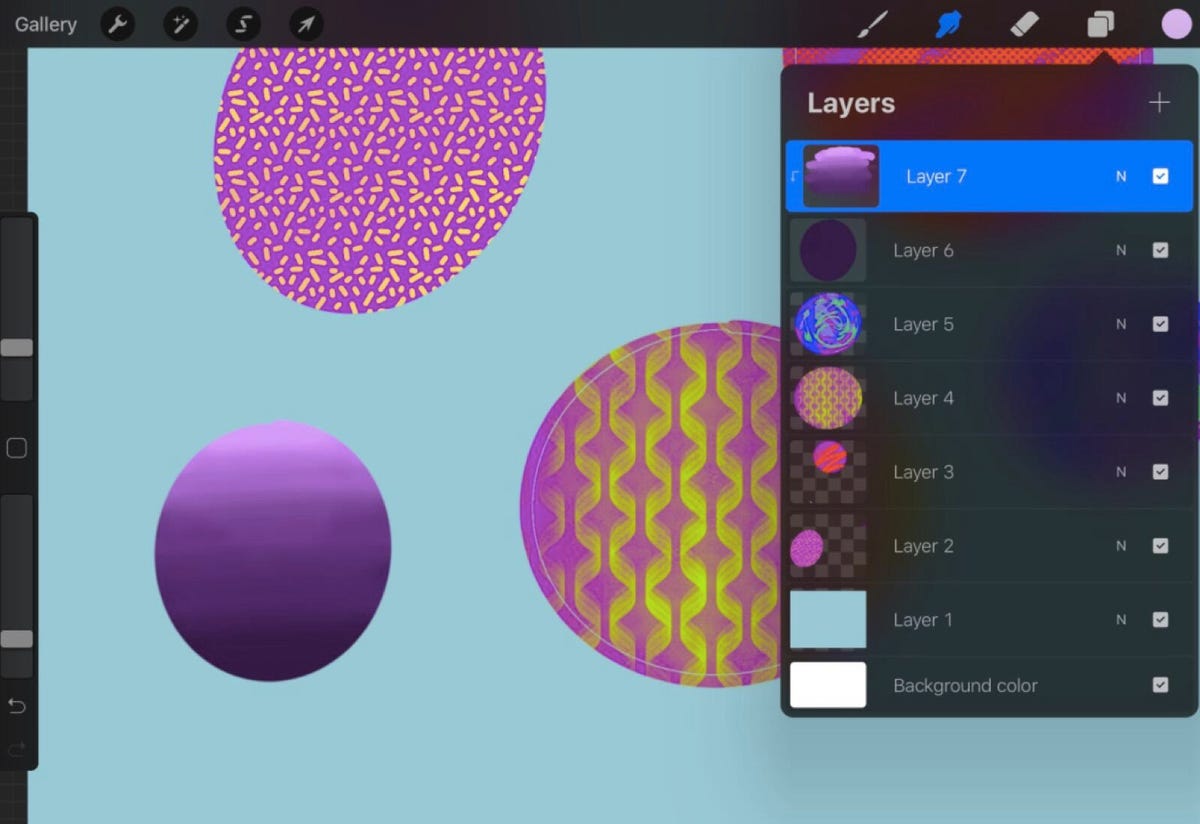

Clipping mask on layer 7.
Shelby Brown/CNET
Making color palettes
Depending on your art style, keeping colors consistent can make for a better final product. Tap the circle of color in the upper right corner of the app to open the color disc panel. If you want, instead of a disc, you can customize and use a classic gradient or get technical with sliding bars that control color value.
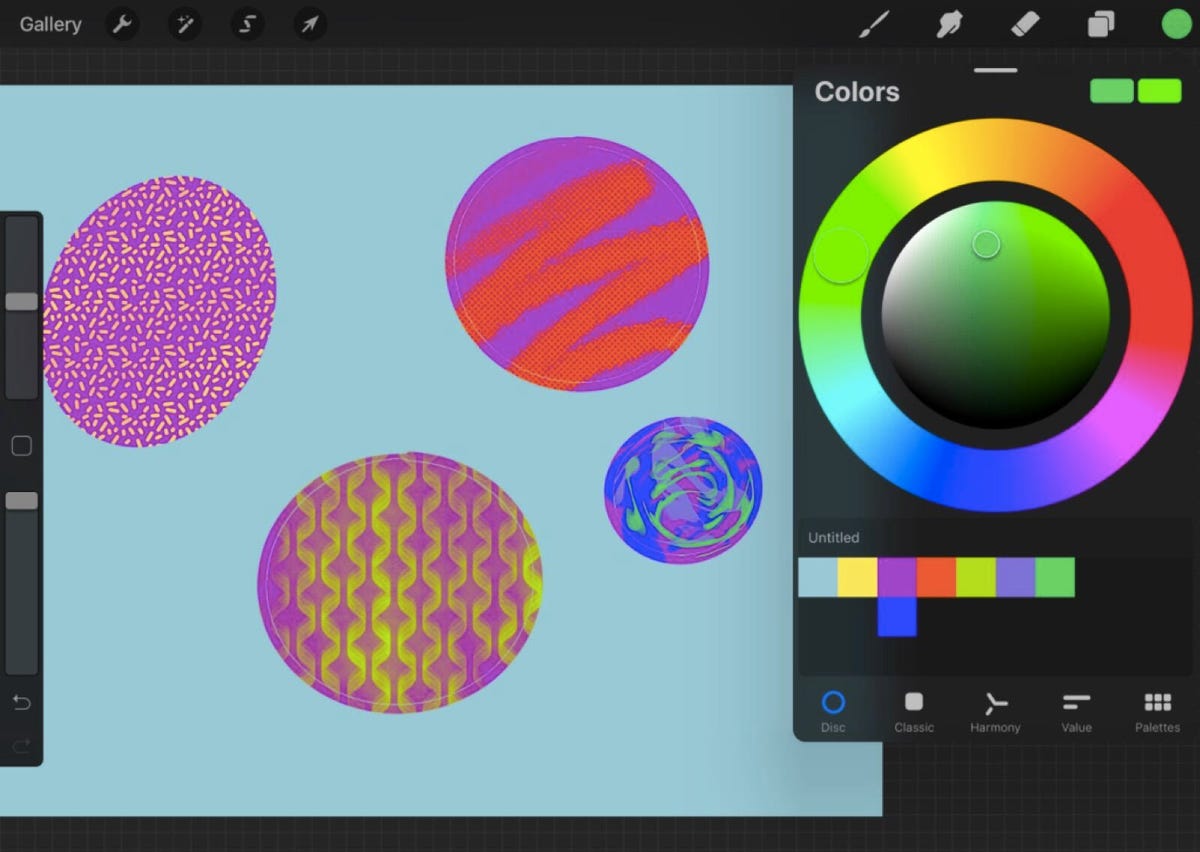

A look at the color disc and colors added to a new palette.
Shelby Brown/CNET
Procreate has three premade palettes that you can set as default, or you can also add your own color palette a few different ways. To manually build a color palette, tap the “+” in the top right next to Palettes. This will create a new empty palette that will be available when you go back to the color panel.
To add colors to the palette, just select the color you want and tap in the palette box to keep it. If you change your mind, tap and hold on a color to delete it from your palette. If you go back to the palettes tab, you can name it or delete a palette if you don’t need it anymore.
When you tap the “+” you can also choose New from Camera, New from File or New from Photos. New from Camera opens your iPad’s camera and lets you capture a color palette by snapping a photo. You can also use New from File or New from Photos to use a premade palette from another artist or generate a palette from a reference photo.
Eyedropper tool
One of my favorite parts of Procreate is how much you can customize the colors you use, and in such detail. With the eyedropper tool (which is also customizable in gesture controls) you can hold down over a color to pick it up, or hold down, drag and zoom to get more detail in your use of color.
This tool is also helpful when you’re trying to achieve a smoother blend.
ColorDrop
The Procreate ColorDrop feature acts like the bucket fill once did on Microsoft Paint. To use ColorDrop, choose the color you want from your palette, and tap and hold on the color circle in the upper right corner. Drag the color to where you want it on the canvas and let go. The color will either fill your whole canvas, or work around the shapes you’ve already placed.
Sometimes if you use ColorDrop, you might notice that it “spills” on the whole canvas. I’ve had better luck controlling the color if I used Quickshape, but you can also continue to hold down and drag left or right to adjust the ColorDrop threshold.
Manual blending
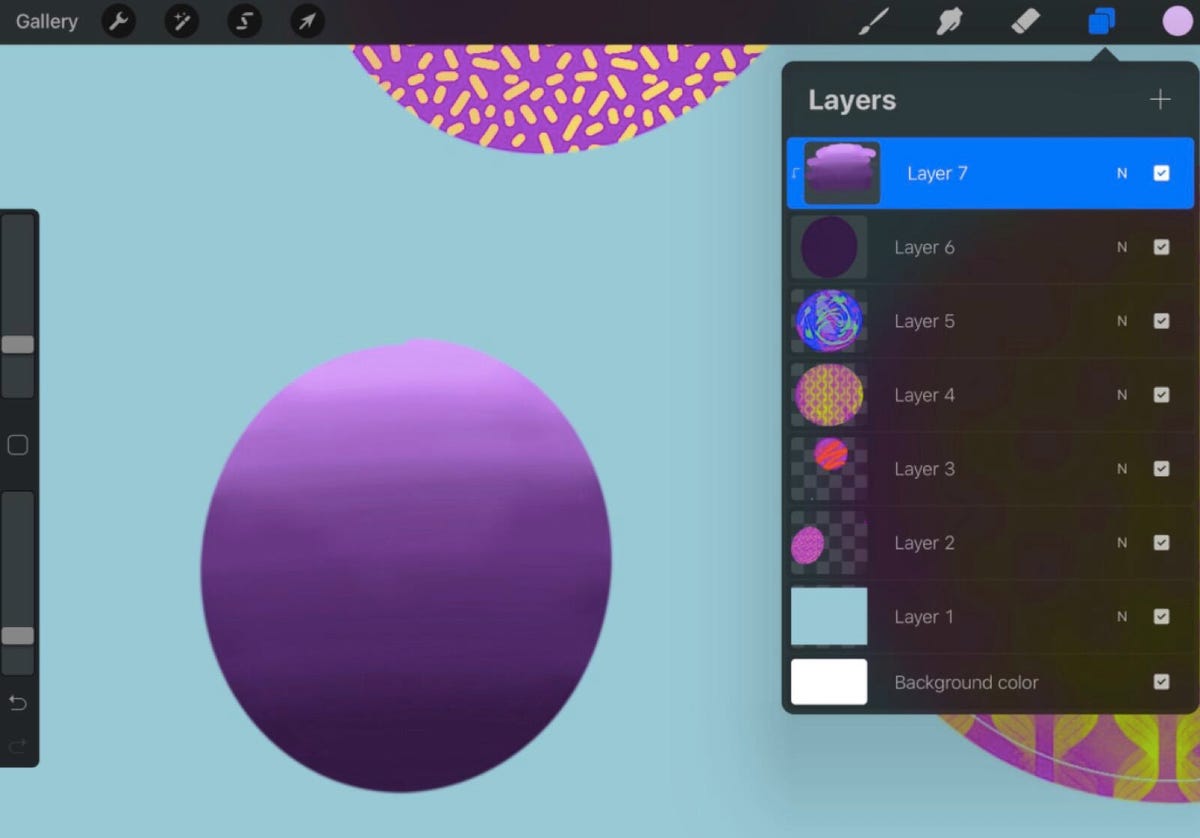

Using blend mode on layer 7’s clipping mask.
Shelby Brown/CNET
Zooming in on pixels and trying to grab colors to make something look smoother is time-consuming and exhausting. If you’re not quite comfortable with the more advanced blend modes, the smudge tool and Gaussian Blur have saved me many a headache.
The smudge tool lives between the paintbrush and eraser icons in the top right (it looks like a finger pointing diagonally). When you tap the smudge tool, you can select from a number of different brushes to keep consistency with the brush you originally painted with. The brush size and opacity are adjustable on the left-hand side.
Gaussian Blur requires even less work. Once you have the drawing you want to blur, tap the icon that looks like a magic wand in the upper left and choose Gaussian Blur. You can choose to control the blur intensity on the entire layer (slide your pencil back and forth on the screen to increase or decrease the blur) or take a more detailed approach by choosing Pencil (like a more focused approach, similar to the smudge tool).
Adjustment tools
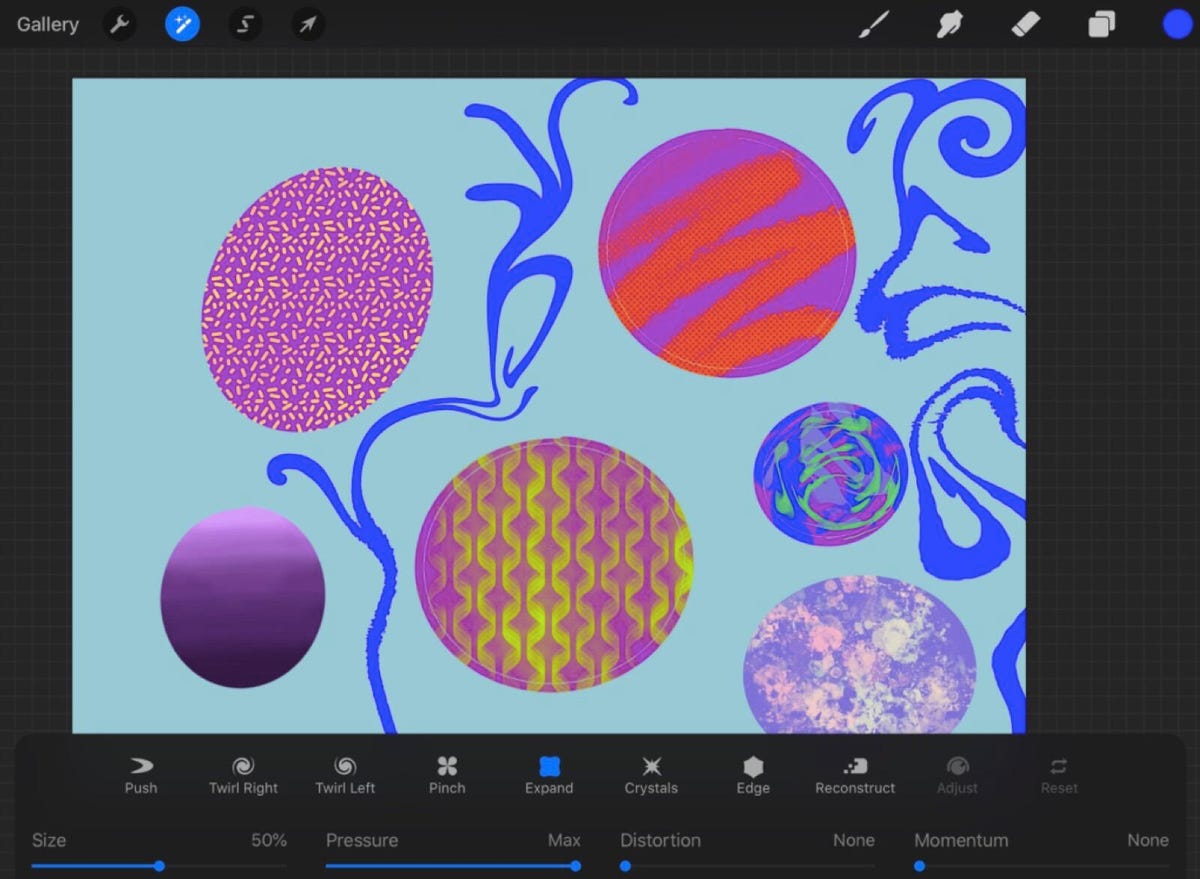

The liquify edit options in the Adjustments tab.
Shelby Brown/CNET
Next to the wrench icon is a little magic wand icon. If you tap that, you’ll see (surprise!) more editing tools. You can experiment with tools like blurring (which can provide some cool depth illusions), opacity and noise (which can give your work a less grainy look). One of my favorites to play with was the Liquify tool. Liquify lets you push, pull, twist and twirl lines.
Brush Studio
Open Brush Studio by tapping a second time on a brush in the library. You’ll find dozens of different ways to customize your brush or create an entirely new brush. There’s a lot going on in here (once again, surprise!) and I’d recommend keeping it simple to start — especially if you don’t plan to create your own brushes. Feel free to experiment though; the Drawing Pad window shows you exactly what a brushstroke will look like with the changes you’ve made. Just tap cancel and nothing will be saved.
Stroke Path is a good place to dip your toes in Brush Studio. Stroke Path — which lets you adjust your brushstroke — includes Spacing, Streamline, Jitter and Fall Off. Each property can be adjusted with a slider and you can see what the brush will look like in Drawing Pad.
Adjusting Spacing changes how smooth (less spacing) or jagged (more spacing, which can actually create a stamp) your stroke is. Streamline also controls a smooth stroke. If you’re interested in using calligraphy or handwriting in your art, increasing the Streamline can eliminate the little shakes that can make lines imperfect.
On the other hand, increasing Jitter makes for a more rough edge on a brushstroke. Lastly, Fall Off plays with the stroke’s opacity, making the end of the stroke fade. The more Fall Off, the shorter your stroke will be before the “ink” runs out.
Importing brushes
There are probably endless combinations of brushes that you can use to create — even without tweaking them in Brush Studio. But many talented designers have premade brush packs that you can download online. I’m partial to importing brush packs from Creative Market, but sometimes artists will sell packs on their websites. Packs can cost a few bucks or be pretty pricey, but most websites let you filter based on price.
Packs can be as niche or broad as you can imagine — basic sketching, fur texture, glitter, risograph, fabric texture, stippling and more.
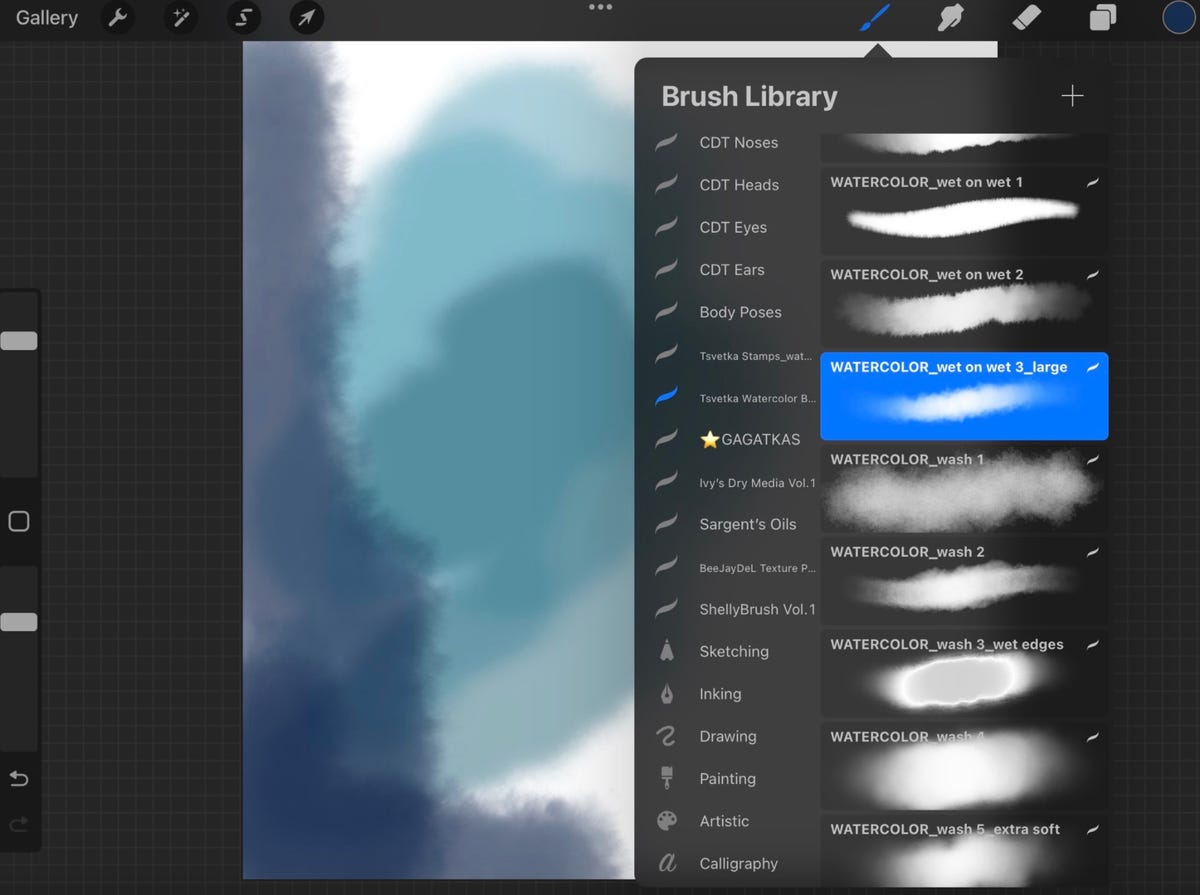

A selection of watercolor brushes I imported from Svetlana Tigai, professional known as Tsvetka, through Cubebrush.
Shelby Brown/CNET
Text
You can incorporate text into your piece with just a few taps. Select the wrench icon and tap Add Text. A text box will pop up on your canvas along with your iPad keyboard where you can type what you want. To edit the text — double-tap the text to select all — and tap the Aa in the top right corner of the keyboard. Tapping Aa will open the text editing suite where you can change the text font, style, size, kerning and more.
Drawing guides and reference photos
No matter what your artistic level is, a bit of guidance is always welcome. One way to do this is by turning on Drawing Guides. Simply tap the wrench icon, toggle on Drawing Guide, and a grid will appear over your canvas. You can make adjustments by tapping Edit Drawing Guide, which offers four different modes:
- 2D Grid: This square grid pops up automatically when you turn on Drawing Guide.
- Isometric: A cube grid, handy for drawing cutaways of rooms and buildings.
Both the 2D and Isometric Grids have sliders to adjust opacity, line thickness and grid size. You. can also toggle on Assisted Drawing, which only lets you draw straight lines — kind of like Quickshape for circles.
- Perspective: Create up to three vanishing points, which can help when you’re trying to achieve depth in a piece. You can also turn on Assisted Drawing to make straight lines.
- Symmetry: Divides the canvas vertically, horizontally, by quadrant or radially. You can create some cool pieces by turning on Assisted Drawing. Radial symmetry with Assisted Drawing turned on lends itself to creating mandala designs.
If you’re drawing from a reference, you can keep the image in a separate window. Tap the wrench icon and toggle on Reference. You can reference the canvas itself, import an image from your iPad photo library, of choose Face, which will open your iPad’s front-facing camera for self-portraits. You can either keep the camera open (like if you were working in front of a mirror) or you can tap Options to take a photo.
Have fun!
There’s a lot going on in Procreate and it can seem overwhelming, but the more you use the app, the easier it gets. Having fun is the most important part. If you’re getting too stressed about not getting a piece “right,” take a break and just doodle. It’s fun (and less pressure) to upload blank coloring sheets to a canvas and experiment with the tools that way. There are dozens of ways to customize Procreate to help you discover or improve your art style.
For more on drawing, check out 5 online drawing classes you can take right now and for quick reference in the app, check out the official Procreate Handbook.
The best Apple iPad apps of all time
